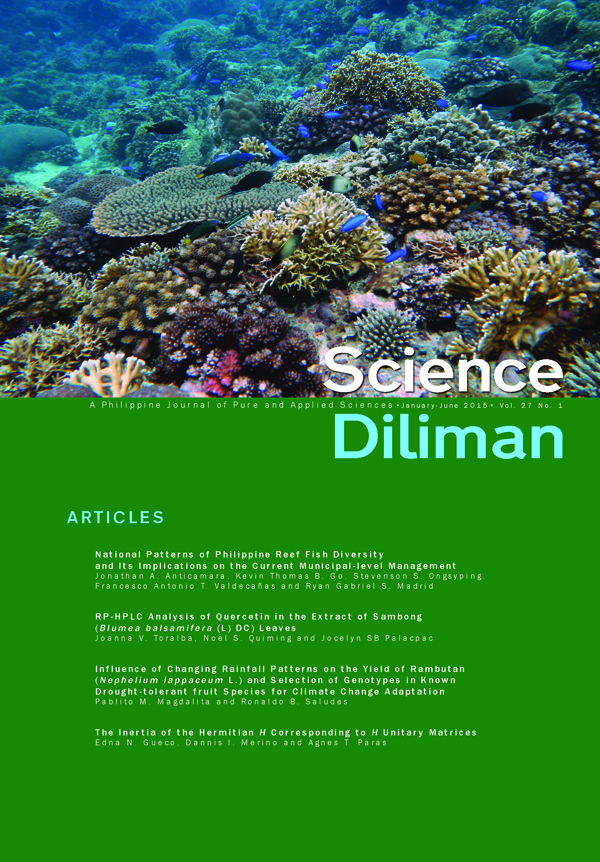Influence of Changing Rainfall Patterns on the Yield of Rambutan (<em>Nephelium lappaceum</em> L.) and Selection of Genotypes <br>in Known Drought-tolerant Fruit Species for Climate Change Adaptation
Abstract
In fruit crop production, rainfall, water stress, temperature, and wind are key variables for success, and the present changes in rainfall patterns could affect the flowering and yield of the rambutan (Nephelium lappaceum L). Other fruit species like macopa (Syzygium samarangense), siniguelas (Spondias purpurea), and native santol or cotton fruit (Sandoricum koetjape) remain productive despite extreme climatic changes. This study assessed the influence of rainfall on rambutan yield and evaluated and selected tree genotypes of known drought-tolerant fruit species. Rambutan yield in a selected farm in Calauan, Laguna, Philippines, dropped remarkably from 152.2 kg/tree in 2008 to 8.6 kg/tree in 2009. This reduction could be attributed to the high rainfall in April 2009 at 334.4 mm, and possibly other environmental factors like temperature, relative humidity, solar radiation, and strong wind. Furthermore, wet months in 2009 also inhibited the flowering of rambutan. However, a low yield obtained in 2010 at 45.5 kg/tree could be partly attributed to the very low rainfall in May 2010 at only 9.1 mm. On the other hand, in relation to changing climate, selection of tree genotypes for use as varieties in known drought- and flood-tolerant fruit species based on important fruit qualities like sweetness, juiciness, and high edible portion was done. Among 103 macopa genotypes, Mc-13, 43, and 91 were selected and the best (i.e. , Mc-13) had sweet (7.15 °Brix) and crispy fruits weighing 49.44 g, creamy white (RHCC 155 A), and had high edible portion (EP, 93.22%). Among 114 siniguelas genotypes, Sg-41, 42 and 105 were selected and the best selection (i.e., Sg-41), had sweet (12.50 °Brix) and juicy fruit weighing 20.42 g, ruby red (RHCC 59 A), and had high EP (83.27%). Among 101 native santol genotypes, Sn-47, 59, and 74 were selected and the best selection (i.e. , Sn-59) had relatively sweet (5.56 °Brix) and juicy fruits weighing 51.96 g, maize yellow (RHCC 21 B), and had high EP (82.20%). These selections are recommended for planting in marginal and drought-prone areas for climate change adaptation. In addition, they can fare better in flooded areas in the face of climate change since they are very hardy, and have woody and strong roots that can resist strong wind and increasing amount of rainfall brought about by climate change. Keywords: Climate change, rainfall, macopa, native santol, rambutan, siniguelas
How to Cite
MAGDALITA, Pablito M.; SALUDES, Ronaldo B..
Influence of Changing Rainfall Patterns on the Yield of Rambutan (Nephelium lappaceum L.) and Selection of Genotypes
in Known Drought-tolerant Fruit Species for Climate Change Adaptation. Science Diliman: A Journal of Pure and Applied Sciences, [S.l.], v. 27, n. 1, july 2015. ISSN 2012-0818. Available at: <https://journals.upd.edu.ph/index.php/sciencediliman/article/view/4610>. Date accessed: 27 sep. 2025.
in Known Drought-tolerant Fruit Species for Climate Change Adaptation. Science Diliman: A Journal of Pure and Applied Sciences, [S.l.], v. 27, n. 1, july 2015. ISSN 2012-0818. Available at: <https://journals.upd.edu.ph/index.php/sciencediliman/article/view/4610>. Date accessed: 27 sep. 2025.
Issue
Section
Articles
Submission of a manuscript implies: that the work described has not been published before (except in the form of an abstract or as part of a published lecture, review, or thesis); that it is not under consideration for publication elsewhere; that its publication has been approved by all co-authors, if any, as well as by the responsible authorities at the institute where the work has been carried out; that, if and when the manuscript is accepted for publication, the authors agree to the automatic transfer of the copyright to the publisher; that the manuscript will not be published elsewhere in any language without the consent of the copyright holders; that written permission of the copyright holder is obtained by the authors for material used from other copyrighted sources; and that any costs associated with obtaining this permission are the authors’ responsibility.



